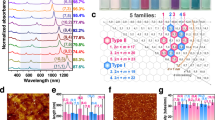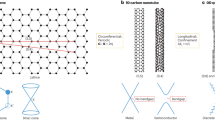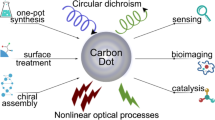Abstract
Non-invasive, high-throughput spectroscopic techniques can identify chiral indices (n,m) of carbon nanotubes down to the single-tube level1,2,3,4,5,6. Yet, for complete characterization and to unlock full functionality, the handedness, the structural property associated with mirror symmetry breaking, also needs to be identified accurately and efficiently7,8,9,10,11,12,13,14. So far, optical methods fail in the handedness characterization of single nanotubes because of the extremely weak chiroptical signals (roughly 10−7) compared with the excitation light15,16. Here we demonstrate the complete structure identification of single nanotubes in terms of both chiral indices and handedness by Rayleigh scattering circular dichroism. Our method is based on the background-free feature of Rayleigh scattering collected at an oblique angle, which enhances the nanotube’s chiroptical signal by three to four orders of magnitude compared with conventional absorption circular dichroism. We measured a total of 30 single-walled carbon nanotubes including both semiconducting and metallic nanotubes and found that their absolute chiroptical signals show a distinct structure dependence, which can be qualitatively understood through tight-binding calculations. Our strategy enables the exploration of handedness-related functionality of single nanotubes and provides a facile platform for chiral discrimination and chiral device exploration at the level of individual nanomaterials.
This is a preview of subscription content, access via your institution
Access options
Access Nature and 54 other Nature Portfolio journals
Get Nature+, our best-value online-access subscription
$29.99 / 30 days
cancel any time
Subscribe to this journal
Receive 12 print issues and online access
$259.00 per year
only $21.58 per issue
Buy this article
- Purchase on Springer Link
- Instant access to full article PDF
Prices may be subject to local taxes which are calculated during checkout




Similar content being viewed by others
Data availability
The data supporting the findings of this study are available within the paper, Extended Data Figs. 1 and 2 and the Supplementary Information. Extra data are available from the corresponding author upon request. Source data are provided with this paper.
References
Bachilo, S. M. et al. Structure-assigned optical spectra of single-walled carbon nanotubes. Science 298, 2361–2366 (2002).
Sfeir, M. Y. et al. Probing electronic transitions in individual carbon nanotubes by Rayleigh scattering. Science 306, 1540–1543 (2004).
Dresselhaus, M. S., Dresselhaus, G., Saito, R. & Jorio, A. Raman spectroscopy of carbon nanotubes. Phys. Rep. 409, 47–99 (2005).
Liu, K. et al. An atlas of carbon nanotube optical transitions. Nat. Nanotechnol. 7, 325–329 (2012).
Liu, K. et al. High-throughput optical imaging and spectroscopy of individual carbon nanotubes in devices. Nat. Nanotechnol. 8, 917–922 (2013).
Liu, K. H. et al. Systematic determination of absolute absorption cross-section of individual carbon nanotubes. Proc. Natl Acad. Sci. USA 111, 7564–7569 (2014).
Samsonidze, G. G. et al. Interband optical transitions in left- and right-handed single-wall carbon nanotubes. Phys. Rev. B 69, 205402 (2004).
Peng, X. et al. Optically active single-walled carbon nanotubes. Nat. Nanotechnol. 2, 361–365 (2007).
Ghosh, S., Bachilo, S. M. & Weisman, R. B. Advanced sorting of single-walled carbon nanotubes by nonlinear density-gradient ultracentrifugation. Nat. Nanotechnol. 5, 443–450 (2010).
Wei, X. et al. Experimental determination of excitonic band structures of single-walled carbon nanotubes using circular dichroism spectra. Nat. Commun. 7, 12899 (2016).
Ao, G., Streit, J. K., Fagan, J. A. & Zheng, M. Differentiating left- and right-handed carbon nanotubes by DNA. J. Am. Chem. Soc. 138, 16677–16685 (2016).
Magg, M. et al. Resonance raman optical activity spectra of single-walled carbon nanotube enantiomers. J. Phys. Chem. Lett. 7, 221–225 (2016).
Sato, N., Tatsumi, Y. & Saito, R. Circular dichroism of single-wall carbon nanotubes. Phys. Rev. B 95, 155436 (2017).
Brandt, J. R., Salerno, F. & Fuchter, M. J. The added value of small-molecule chirality in technological applications. Nat. Rev. Chem. 1, 0045 (2017).
Sanchez-Castillo, A., Roman-Velazquez, C. E. & Noguez, C. Optical circular dichroism of single-wall carbon nanotubes. Phys. Rev. B 73, 045401 (2006).
Barron, L. D. Molecular Light Scattering and Optical Activity (Cambridge Univ. Press, 2009).
Tang, Y. & Cohen, A. E. Optical chirality and its interaction with matter. Phys. Rev. Lett. 104, 163901 (2010).
Yang, N. & Cohen, A. E. Local geometry of electromagnetic fields and its role in molecular multipole transitions. J. Phys. Chem. B 115, 5304–5311 (2011).
Sioncke, S., Verbiest, T. & Persoons, A. Second-order nonlinear optical properties of chiral materials. Mater. Sci. Eng. R. Rep. 42, 115–155 (2003).
Fischer, P. & Hache, F. Nonlinear optical spectroscopy of chiral molecules. Chirality 17, 421–437 (2005).
Persoons, A. Nonlinear optics, chirality, magneto-optics: a serendipitous road. Opt. Mater. Express 1, 5–16 (2011).
Collins, J. T. et al. Chirality and chiroptical effects in metal nanostructures: fundamentals and current trends. Adv. Opt. Mater. 5, 1700182 (2017).
Collins, J. et al. First observation of optical activity in hyper-Rayleigh scattering. Phys. Rev. X. 9, 011024 (2019).
Sachs, J., Gunther, J. P., Mark, A. G. & Fischer, P. Chiroptical spectroscopy of a freely diffusing single nanoparticle. Nat. Commun. 11, 4513 (2020).
Ohnoutek, L. et al. Single nanoparticle chiroptics in a liquid: optical activity in hyper-Rayleigh scattering from Au helicoids. Nano Lett. 20, 5792–5798 (2020).
Tang, Y., Cook, T. A. & Cohen, A. E. Limits on fluorescence detected circular dichroism of single helicene molecules. J. Phys. Chem. A 113, 6213–6216 (2009).
Westphal, C., Bansmann, J., Getzlaff, M. & Schonhense, G. Circular dichroism in the angular distribution of photoelectrons from oriented CO molecules. Phys. Rev. Lett. 63, 151–154 (1989).
Verbiest, T., Kauranen, M., Van Rompaey, Y. & Persoons, A. Optical activity of anisotropic achiral surfaces. Phys. Rev. Lett. 77, 1456 (1996).
Yokoyama, A., Yoshida, M., Ishii, A. & Kato, Y. K. Giant circular dichroism in individual carbon nanotubes induced by extrinsic chirality. Phys. Rev. X 4, 011005 (2014).
Odom, T. W., Huang, J.-L., Kim, P. & Lieber, C. M. Atomic structure and electronic properties of single-walled carbon nanotubes. Nature 391, 62 (1998).
Liu, Z. et al. Determination of optical isomers for left-handed or right-handed chiral double-wall carbon nanotubes. Phys. Rev. Lett. 95, 187406 (2005).
Saito, R., Dresselhaus, G. & Dresselhaus, M. Trigonal warping effect of carbon nanotubes. Phys. Rev. B 61, 2981 (2000).
Shindo, Y., Nakagawa, M. & Ohmi, Y. On the problems of CD spectropolarimeters. II: artifacts in CD spectrometers. Appl. Spectrosc. 39, 860–868 (1985).
Kuroda, R., Harada, T. & Shindo, Y. A solid-state dedicated circular dichroism spectrophotometer: development and application. Rev. Sci. Instrum. 72, 3802–3810 (2001).
He, M., Zhang, S. & Zhang, J. Horizontal single-walled carbon nanotube arrays: controlled synthesis, characterizations, and applications. Chem. Rev. 120, 12592–12684 (2020).
Xiang, R. et al. One-dimensional van der Waals heterostructures. Science 367, 537–542 (2020).
Acknowledgements
This work was supported by the National Natural Science Foundation of China under grant numbers 52021006 (J. Zhang), 52025023 (K.L.) and 51991342 (K.L.); the Key R&D Programme of Guangdong Province with grant numbers 2020B010189001 (K.L.), 2019B010931001 (K.L.) and 2018B030327001 (K.L.); the National Key R&D Programme of China under grant numbers 2016YFA0300903 (K.L.), 2017YFA0303800 (K.L.) and 2016YFA0300804 (P.G.); the Strategic Priority Research Programme of Chinese Academy of Sciences with grant number XDB33000000 (K.L.); Beijing Natural Science Foundation under grant number JQ19004 (K.L.); Beijing Graphene Innovation Programme under grant number Z181100004818003 (K.L.); the Pearl River Talent Recruitment Programme of Guangdong Province with grant number 2019ZT08C321 (K.L.); National Equipment Programme of China under grant number ZDYZ2015-1 (X.B.); National Postdoctoral Programme for Innovative Talents under award number BX20190016 (C.L.) and China Postdoctoral Science Foundation under award numbers 2019M660280 (C.L.) and 2019M660281 (R.Q.).
Author information
Authors and Affiliations
Contributions
K.L. conceived and supervised the project. F.Y., Y.S. and H.M. designed and built the optical setup. F.Y., W.Y. and C.L. conducted the optical experiments. C.L. performed sample growth and the scanning tunnelling microscope experiments. Y.S., Y.Y., F.Y., W.Y. and H.M. contributed the theoretical calculations. R.Q., P.G. and X.B. conducted the transmission electron microscopy experiments. C.W., C.M., J. Zhao, Z.S., S.M., F.W. and J. Zhang suggested optical experiments. All of the authors discussed the results and wrote the paper.
Corresponding author
Ethics declarations
Competing interests
The authors declare no competing interests.
Additional information
Peer review information Nature Nanotechnology thanks the anonymous reviewers for their contribution to the peer review of this work.
Publisher’s note Springer Nature remains neutral with regard to jurisdictional claims in published maps and institutional affiliations.
Extended data
Extended Data Fig. 1 Synthesis of SWNTs.
a, Schematic of SWNTs growth across open slit by kite-flying growth mechanism. b, SEM image of the as-grown SWNTs.
Extended Data Fig. 2 Structure-dependent Ray-CD peak intensity.
a,b, Calculated mapping of Ray-CD peak intensity as a function of the diameter and chiral angle of S33 transition for semiconducting type I (a) and type II (b) nanotubes. c,d, Calculated (green triangles) versus experimental (orange circles) peak intensities of Ray-CD for S33 transitions as a function of diameter for type I (c) and type II (d) family. The chiral angle of selected nanotubes is around 19 ° (black lines in calculated mappings). e,f, Calculated (green triangles) versus experimental (orange circles) peak intensities of Ray-CD for S33 transitions as a function of the chiral angle for type I (e) and type II (f) family. The diameters of the selected nanotubes are around 2.0 nm (white lines in calculated mappings). Error bars are derived from absolute Ray-CD values of armchair samples.
Supplementary information
Supplementary Information
Supplementary Figs. 1–11, Tables 1 and 2, Notes 1–7 and References.
Source data
Source Data Fig. 2
Statistical source data.
Source Data Fig. 3
Statistical source data.
Source Data Fig. 4
Statistical source data.
Source Data Extended Data Fig. 1
Statistical source data.
Rights and permissions
About this article
Cite this article
Yao, F., Yu, W., Liu, C. et al. Complete structural characterization of single carbon nanotubes by Rayleigh scattering circular dichroism. Nat. Nanotechnol. 16, 1073–1078 (2021). https://doi.org/10.1038/s41565-021-00953-w
Received:
Accepted:
Published:
Issue Date:
DOI: https://doi.org/10.1038/s41565-021-00953-w
This article is cited by
-
Heteroepitaxial growth of Au@Pd core–shell nanocrystals with intrinsic chiral surfaces for enantiomeric recognition
Rare Metals (2024)
-
A new technique to identify the handedness of single nanomaterial
Science China Chemistry (2022)



